|
Contents |
 |
Grinding Wheel
Making a grinding wheel from a rotary tool
grinding disc. |
 |
Weapon Racks
Making a variety of racks to hold weapons and
shields. |
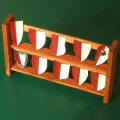 |
Kite Shields
How to make kite shields from an empty plastic
milk bottle. |
 |
Textured Shields
Making textured shields from an empty plastic
milk bottle. |
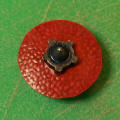 |
Shield Bosses
How to make shield bosses from superglue caps. |
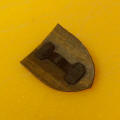 |
Shield Handles
Making handles for shields from an empty water
bottle. |
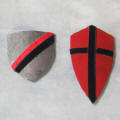 |
Shield Designs
Adding designs to your shields using adhesive
tape.
|
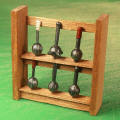 |
Maces
Instructions for making a variety of maces from
beads and cocktail sticks. |
 |
Rapiers
How to make simple rapiers from dressmakers'
pins. |
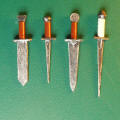 |
Swords
How to make a variety of swords from plastic card
and other cheap materials. |
 |
Shortswords & Daggers
Making shortswords and daggers from a comb and a
hairbrush. |
 |
Practice Swords
Instructions for making two styles of practice
sword from pop-rivets. |
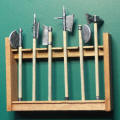 |
Polearms
How to make a variety of polearms from cocktail
sticks and other cheap materials. |
 |
Spears
Making spears from cocktail sticks and comb
teeth. |
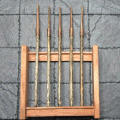 |
Javelins
How to make javelins from cocktail sticks and
cocktail forks. |
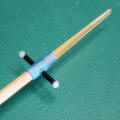 |
Boar Spears
How to make boar spears from cocktail sticks and
cocktail forks. |
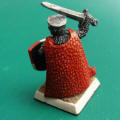 |
Cloaks
Making dragon-scale cloaks from an empty plastic
milk bottle. |
 |
Greaves
How to make pairs of greaves from an empty
plastic milk bottle. |
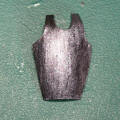 |
Breastplates
How to make breastplates from an empty
plastic milk bottle. |
|
|
|
Grinding Wheel
(Click thumbnails for
larger images) |
|
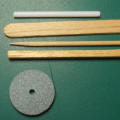 |
Materials & Equipment
Grinding disc for a rotary tool
Basswood strips
Cocktail stick
Plastic tube (cotton bud stem)
PVA
Craft knife
Pin vice & drill bit
Razor saw & mitre box
Paint & paintbrush |
 |
Stage 1
The cocktail stick will
provide the axle for the wheel - check that it fits through the hole in
the disc.
Paint the grinding disc with
thinned black paint. Allow to
dry. |
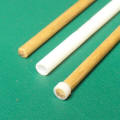 |
Stage 2
Trim the tapered part from
one end of the cocktail stick, then cut a piece 23mm in length. Cut a
piece of the plastic tube about 1.5mm in length and push it onto one end
of the stick. |
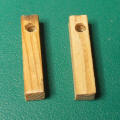 |
Stage 3
Fit a drill bit with the same
diameter as the cocktail stick into the pin vice. Drill a hole near one
end of a piece of 3mm square section basswood. Cut to a length around
15mm long for one of the vertical supports. Make a second identical
piece. |
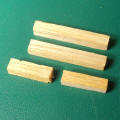 |
Stage 4
Cut two pieces of 3mm square
basswood 22mm in length for the base of the sides. Cut two more pieces 12mm in length for the cross-braces. |
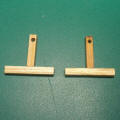 |
Stage 5
Attach the two vertical
supports to the centres of the two bases with PVA. Check the holes for
the axle are pointing the right way. Allow to dry. |
 |
Stage 6
Cut a piece of a coffee
stirrer to 12mm x 4mm. Drill a hole near one end of the piece to fit the
cocktail stick. Trim and sand both ends to round off the corners as
shown. |
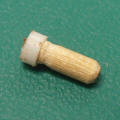 |
Stage 7
Round the cut end of the
cocktail stick. Cut to a 6mm length and add a 1.5mm collar of the
plastic tubing. |
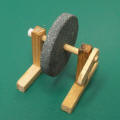 |
Stage 8
Thread the axle through one
side support, the wheel, the second side support and the handle offset
piece. |
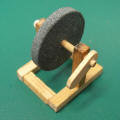 |
Stage 9
With a little PVA, glue the
two cross braces in place between the side supports.
Allow to dry. |
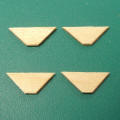 |
Stage 10
Cut four bracing pieces as
shown, to fit against the side supports. |
 |
Stage 11
Glue these
pieces in place with a little PVA. |
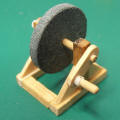 |
Stage 12
Glue the
handle in place with PVA. |
 |
Stage 13
Add a small
drop of PVA to hold the wheel in place on the axle, and another to hold
the turning handle.
Allow to dry. |
 |
Stage 14
Add paint or
stain to the wooden parts, and paint the two plastic collars to complete
the model. |
|
Weapon & Shield Racks
(Click thumbnails for
larger images) |
|
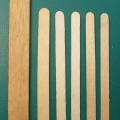 |
Materials & Tools:
Basswood or Balsa
Coffee stirrers
Razor saw and Mitre block
Guillotine
PVA
Sandpaper / Emery Board
Brown ink wash
|
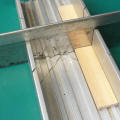 |
Stage 1
Cut two side
supports for the rack using the razor saw and mitre box. I made mine
50mm (2 inches) tall from 12mm x 3mm (1/2" x 1/8") basswood strip. |
 |
Stage 2
Cut four
pieces of coffee stirrer to the width of your rack. I opted for 64mm
(2.5"). I used a home-made guillotine to cut the strips to length, but
you can use the razor saw instead. |
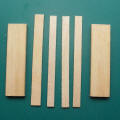 |
Stage 3
Lightly sand
the pieces with sandpaper or an emery board. |
 |
Stage 4
Apply a small
amount of PVA glue to one side of one of the coffee stirrer pieces, and
attach it near one edge of a second piece. Allow to dry for a few
minutes. |
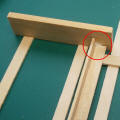 |
Stage 5
Glue the piece
to each of the side supports near the bottom front edge. Use the other
cut strips to keep the spacing correct, and spare pieces of wood or
plastic as supports. Allow to dry for a few minutes. |
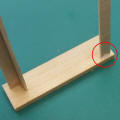 |
Stage 6
Attach another
coffee stirrer near the upper-back corner of the side supports with a
drop of PVA. Allow to dry for a few minutes. |
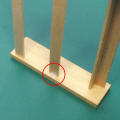 |
Stage 7
Using PVA,
attach the fourth strip about halfway up the rack as shown. Make sure
the rack is square and allow the glue to dry thoroughly for at least an
hour. |
 |
Stage 8
Apply an ink
wash to the wood to stain it to a suitable brown colour. If you prefer,
you can paint it, but I like to preserve the natural wood-grain.
Swords /
Rapiers |
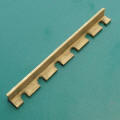 |
Option A
To make a rack
to hold pole-arms or spears, you can drill holes and cut slots to form
the upper cross-piece. |
 |
Example A
A rack for
pole-arms or spears.
Pole-arms |
 |
Option B
For shorter
weapons or shields, you can have two layers. The middle shelf is made in
the same manner as Stage 5, but is glued with the vertical strip at the
back, to support the lower layer.
Maces |
|
Kite
Shields from Milk Bottles
(Click thumbnails for
larger images) |
|
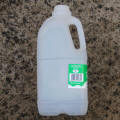 |
Materials & Equipment
Empty plastic
milk bottle
Craft knife /
sharp scissors
Primer
Acrylic paint
Brushes |
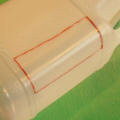 |
Stage 1
Wash and dry the milk bottle,
and remove the label. Cut out one or more of the corner panels as shown. |
 |
Stage 2
Draw or print a template on
paper, and attach it to one of the panels with masking tape. You can get
about 10 shields from one of the panels from a 2-litre/4-pint bottle,
assuming they are roughly 25-28mm scale. |
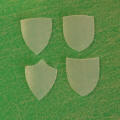 |
Stage 3
Carefully cut out the shield
shapes with a sharp craft knife. You can use scissors if you like, but
they will need to be very sharp or you won't get crisp edges. |
 |
Stage 4
Undercoat the shields on both
sides, allowing ample drying time before undercoating the second side. |
 |
Stage 5
Paint designs on the
shields to finish them. I mounted mine on a rack, but they could also be
used to decorate castle walls or on the sides of a Viking longboat. |
 |
Templates
Click the image to open a PDF
file with templates for 72 variations on shield shapes. The outlines
should be about right for 28mm scale shields when printed at Actual
Size. |
|
|
|
|
|
Textured Shields from Milk
Bottles
(Click thumbnails for
larger images) |
|
 |
Materials & Equipment
Empty plastic
milk bottle
Craft knife /
sharp scissors
Primer
Acrylic paint
& ink
Brushes |
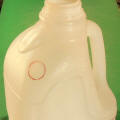 |
Option 1 - Stage 1
Wash and dry the milk bottle,
and remove the label. Cut out one or more of the panels at the shoulder
of the bottle in the marked position. It is much easier to remove a
larger section first, and refine the shape afterwards. |
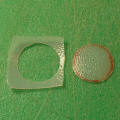 |
Option 1 - Stage 2
Draw a circle around a coin
or using a circle stencil, and cut out the shape with a sharp craft
knife. You can use scissors if you like, but they will need to very
sharp or you won't get crisp edges. |
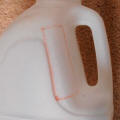 |
Option 2 - Stage 1
Cut out the panel shown here,
which is suitable for making textured kite shields. |
 |
Templates
Click the image to open a PDF
file with templates for 72 variations on shield shapes. The outlines
should be about right for 28mm scale shields when printed at Actual
Size. |
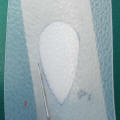 |
Option 2 -
Stage 2
Attach a template to the
plastic, and cut around the outline with a sharp knife.
|
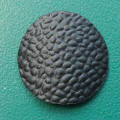 |
Stage 3
Undercoat the shields on both
sides, allowing ample drying time before undercoating the second side. |
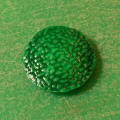 |
Stage 4
The plastic has a texture
which looks a little like rough scaly skin. First I applied a green
basecoat to the shield, and then an ink wash to accentuate this texture.
|
 |
Example 2
This is a kite shield
variant, made using the second option, with a boss attached. This time I
opted for red scales.
|
|
Shield Bosses from
Superglue Caps
(Click thumbnails for
larger images) |
|
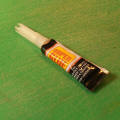 |
Materials & Equipment
Cap from a
tube of superglue
Craft knife
Model shield
Superglue
Tweezers
Primer
Paint &
brushes |
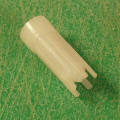 |
Stage 1
Take the cap from an empty
tube of superglue. Clean the cap if necessary. |
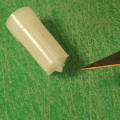 |
Stage 2
Using the craft knife, remove
the five spikes around the edge of the cap, as shown. |
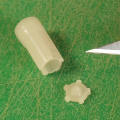 |
Option 1 - Stage 3
Carefully remove the top of
the cap using the craft knife. You should end up with a piece around 1mm
thick at the edges with a central bump. |
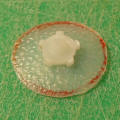 |
Option 1 - Stage 4
Attach the piece to the
centre of a round shield with superglue. You will probably need tweezers
to avoid getting glue on your fingers, and accurately position the
pieces.
|
 |
Option 1 - Stage 5
Apply primer
and then paint the shield in your chosen colour scheme.
|
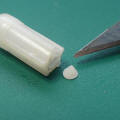 |
Option 2 -
Stage 3
Carefully remove the small
cone from the top of the cap. |
 |
Option 2 -
Stage 4
Attach the piece to a kite shield with superglue. You will probably need tweezers
to avoid getting glue on your fingers, and accurately position the
pieces.
|
 |
Option 2 -
Stage 5
Apply primer
and then paint the shield in your chosen colour scheme.
|
|
Shield Handles from
Water Bottles
(Click thumbnails for
larger images) |
|
 |
Materials & Equipment
Empty
bottle with flat sides and ridges
Craft knife
Model shield
Superglue
Tweezers
Primer
Paint &
brushes |
 |
Stage 1
Wash and dry the bottle,
and remove the label. Cut out one or more of the panels at the side
of the bottle in the marked position. It is much easier to remove a
larger section first, and refine the shape afterwards. |
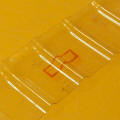 |
Stage 2
Cut a small rectangle from
the panel using the craft knife. The ridge will form the strap of the
handle. |
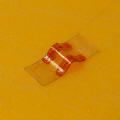 |
Stage 3
Carefully remove the material
shown in the image using the craft knife. Trim all the sharp corners. |
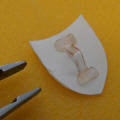 |
Stage 4
Attach the piece to the
back of a shield with superglue. You will probably need tweezers
to avoid getting glue on your fingers, and accurately position the
pieces.
|
 |
Stage 5
Apply primer
and then paint the shield and handle in your chosen colour scheme.
|
|
Shield Designs from
Adhesive Tape,
from an idea by George Fisher
(Click thumbnails for
larger images) |
|
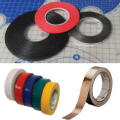 |
Materials & Equipment
Electrical
Insulation Tape or Graphic Arts Tape / Whiteboard Marking Tape or Copper
"Slug-Barrier" Tape
Model shields
Superglue
Craft knife
and tweezers
Primer, paint &
brushes |
 |
Stage 1
Start with some model
shields. You can prime and paint them before adding the tape, or add the
tape first and paint over the raised design. Instructions below for
making shields from an empty milk bottle.
Milk-Bottle
Kite Shields |
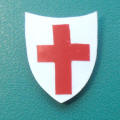 |
Stage 2 -
Option 1
Cut a design from the tape
using a sharp craft knife. Place the design carefully onto the shield
using tweezers. Burnish the tape with the back of your fingernail to
ensure good adhesion and remove any air-bubbles. |
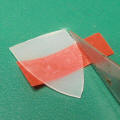 |
Stage 2 -
Option 2
Cut a strip from the tape to
the desired width. Fix the tape in place on the shield, as before. Trim
the tape around the edges of the shield with a sharp craft knife. |
 |
Stage 3
If you aren't happy with the
finish or colour of the tape, spray with primer then paint as desired.
If you wish, you can coat the seams with a little superglue first, to
strengthen the joints.
|
 |
Examples 1
#1 - design
cut first, then placed
#2 - strip
cut, placed and trimmed
#3 - metallic
copper tape covering the whole shield
#4 - tape
fixed in place, then trimmed
|
 |
Examples 2
These are some
of George's designs using the Graphic Arts Tape
#1 - two
strips of colours forming a bend sinister
#2 - two
strips forming a cross with the overlap carefully removed from the intersection |
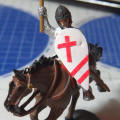 |
Example 3
Another of
George's models with interesting design variations.
|
 |
Example 4
This is the shield
with the copper tape. I added some scratches and dings with the corner
of a file, then applied an ink wash.
|
|
Maces from Beads
(Click thumbnails for
larger images) |
|
 |
Materials & Equipment
Beads
Cocktail
sticks
Plastic tube
(cotton bud shaft)
Masking tape
and cotton thread
PVA, Superglue
Craft knife,
Tweezers, Sandpaper
Paint and
brushes |
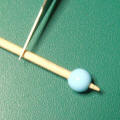 |
Stage 1
Sand the tip of a cocktail
stick to fit through the hole in a bead. Attach the stick to the bead
with a drop of PVA. Trim the point and handle to length - around 15-19mm
looks about right. |
 |
Stage 2 - grip
options
Add a grip from a piece of
plastic tubing, cotton thread or a thin strip of masking tape wrapped
around the handle. |
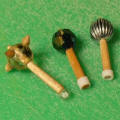 |
Stage 3 -
pommel options
Add a pommel from a short
length of plastic tubing or a small bead. If you use a bead you'll need
to fill the hole and then glue it in place. |
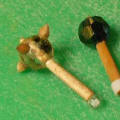 |
Stage 4 -
optional
Make spikes
from short lengths cut from the tips of cocktail sticks. Attach these to
the mace head with superglue. You will probably need tweezers to avoid
getting glue on your fingers, and accurately position the pieces.
|
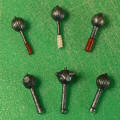 |
Stage 5
Spray with
primer and allow to dry. Paint in suitable colours - I used a gunmetal
basecoat with silver highlights.
|
 |
Example 1
I glued six different maces
to a weapons rack, but you could add them to treasure piles or display
them on the walls of the Great Hall. |
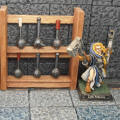 |
Example 2
The rack in a
Hirst Arts room with a figure for scale. |
|
|
|
Rapiers from Pins
(Click thumbnails for
larger images) |
|
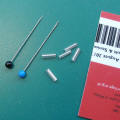 |
Materials & Equipment
Round-headed dressmakers' pins
Bugle Beads or
fine plastic tube
Plastic card
(old ID card or similar)
Superglue
Craft knife,
Tweezers,
Map Pin or Pin
Vice and Fine Drill Bit
Paint and
brushes |
 |
Stage 1
Slide a bugle bead onto the
pin. Alternatively cut a section of the plastic tube to length and use
that instead. |
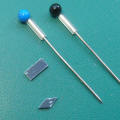 |
Stage 2
Cut a small rectangle or
diamond from the plastic card. This will become the hilt of the sword. |
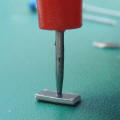 |
Stage 3
Using a map
pin, make a hole in the centre of the hilt piece you just made. If the
plastic is too stiff, you may find it easier to use a pin vice and fine
drill bit. |
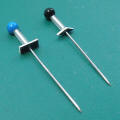 |
Stage 4
Slide the hilt
into place. If necessary, secure everything in place with a tiny amount
of superglue. You may wish to use tweezers for this step. |
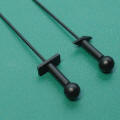 |
Stage 5
Spray with
primer and allow to dry. Paint in suitable colours - I used a gunmetal
basecoat with silver highlights and deep red for the grips.
|
 |
Example 1
Here are two of these rapiers
along with four other swords on a rack.
Sword Instructions |
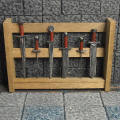 |
Example 2
The same rack
set in a room made from Hirst Arts blocks to show the scale. |
|
|
|
Swords from Plastic
Card
(Click thumbnails for
larger images) |
|
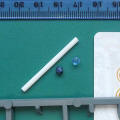 |
Materials & Equipment
Plastic card
(old ID card)
Plastic tube
(cotton bud shaft)
Beads, sprue
Superglue
Primer, paint
and brushes
Craft knife
Tweezers |
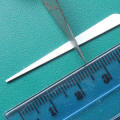 |
Stage 1
Cut a blade shape from thin
plastic card. Blades can vary a lot in length and width, but between
12mm and 30mm (1/2" - 1 1/4") works well for 28mm scale figures. |
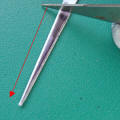 |
Stage 2
For added detail shave the
edges of the blade by back-scraping with the craft knife - place the
knife blade at right angles to the plastic and scrape along the edges.
It may help to colour the plastic using a Sharpie to make it easier to
see how much you have removed. |
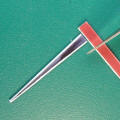 |
Stage 3
Cut a small rectangle from
the plastic card for the hilt. You can vary the shape from a simple
rectangle by trimming the corners at different angles, or rounding them. |
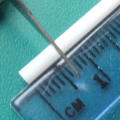 |
Stage 4
Cut a piece of the plastic
tube for the handle - 6mm (1/4") looks about right. For a simple
variation, wrap the handle with a thin strip of masking tape.
|
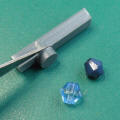 |
Stage 5 -
pommel options
Craft beads
and pieces cut from old sprues make a variety of different pommels.
|
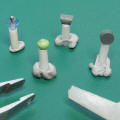 |
Stage 6
Attach the pommel to the
handle with a small drop of superglue. You will probably need tweezers
to avoid getting glue on your fingers, and accurately position the
pieces. If you use a bead for the pommel, you can thread wire through to
strengthen the joint and fill the hole.
|
 |
Stage 7
Attach the sword blade to the
centre of the hilt piece with a small drop of superglue. Use tweezers to
help. Allow the pieces to dry before continuing.
|
 |
Stage 8
Glue the two pieces of the
sword together. Use tweezers to help keep the pieces aligned.
|
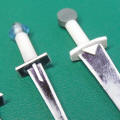 |
Stage 9 -
optional
Add more small pieces of
plastic to the junction of the blade and the hilt for extra detail.
|
 |
Stage 9
Prime and paint in your
choice of colours - I used a gunmetal basecoat with silver highlights
for the metal parts and deep red or white for the grips.
|
 |
Example 2
Here is a rack of
swords made using the same techniques, along with a couple of rapiers.
Rapier Instructions |
|
Shortswords & Daggers
(Click thumbnails for
larger images) |
|
 |
Materials & Equipment
Plastic combs
Plastic
hairbrush
Plastic card
(old ID card)
Superglue
Craft knife
Pin vice & drill bit
Paint & paintbrush |
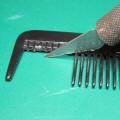 |
Stage 1
Cut a tooth from the plastic
comb with a sharp craft knife. Trim the end to make the cut as square as
possible. Trim the piece shorter if you want to make a dagger |
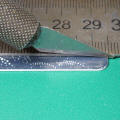 |
Stage 2
Cut a strip of plastic card
to form the hilts of the swords. This should be a little wider than the
comb-teeth blades (see the image for Stage 4). |
 |
Stage 3
Drill a hole in the centre of
the strip, near one end. |
 |
Stage 4
Cut the hilt piece from the
plastic strip. |
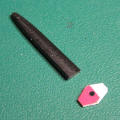 |
Stage 5
(optional)
Trim the corners of the hilt
piece to vary the shapes. |
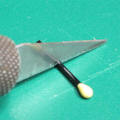 |
Stage 6
Cut a prong from the
hairbrush, and trim it to length. About 6mm (1/4") of "handle" looks
good for 28mm scale. |
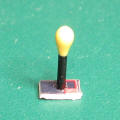 |
Stage 7
Attach the handle into the
hole in the hilt with a small blob of superglue, and allow to set. |
 |
Stage 8
Attach the handle assembly to
the blade with a small blob of superglue, and allow to set. |
 |
Stage 9
Spray with black primer and
allow to dry. |
 |
Stage 10
Paint in suitable colours - I
used a gunmetal basecoat with silver highlights and deep red for the
grips. |
 |
Example 2
Here is a rack of
shortswords and daggers made using these techniques.
Weapon Racks
|
|
Practice Swords from
Rivets,
from an idea by Gabriel
Tullis (Click thumbnails for
larger images) |
|
 |
Materials & Equipment
Pop-rivets
Metal file
Hammer and
anvil (or a second hammer)
Pliers
Primer, paint
and brushes |
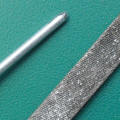 |
Version 1 -
Stage 1
Using the file, make a blunt
point on the end of the shaft of the rivet. |
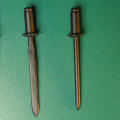 |
Version 1 -Stage 2
Prime & paint in wood colours
and it is done. The image shows one of each version primed in black. |
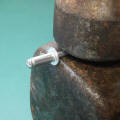 |
Version 2 -
Stage 1
Hold the head of the rivet
with a pair of pliers, and hammer the shaft
into a flat bar. Be sure to work on a firm surface. This is quite
difficult to do, and the process could be less arduous if you heat the
metal before hammering, but be careful if you do. |
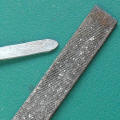 |
Version 2 -
Stage 2
File the end of the shaft to
a blunt point.
|
 |
Version 2 - Stage
3
Prime & paint
in wood colours.
|
|
Polearms
(Click thumbnails for
larger images) |
|
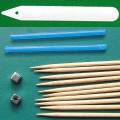 |
Materials & Equipment
Cocktail
sticks, beads, kebab skewer
Plastic tube
(cotton bud shaft)
Plastic Plant
Labels with rounded ends
Craft knife, Superglue
Hole Punch
Primer, Paint &
brushes |
 |
Stage 1 -
(Universal)
Remove the point from one end
of the cocktail stick. Cut a cylinder of plastic tube about 1mm in
length and push this onto the cocktail stick, at or near the trimmed
end. |
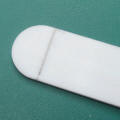 |
Option 1 - Stage 2
Take one of the plastic plant
labels and draw line across about 2mm from the end of the rounded
portion. |
 |
Option 1 - Stage 3
Remove the base plate from
the hole punch. Looking from below, you can now align the plant label on
the line to remove a semi-circle of material from each side. |
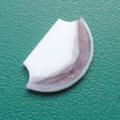 |
Option 1 - Stage 4
Shave the edge of the blade
by back-scraping with the craft knife.
It may help to colour the plastic using a Sharpie to make it easier to
see how much you have removed.
Cut the label on the line. |
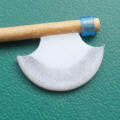 |
Option 1 - Stage 5
Attach the
blade to a cocktail stick shaft with super-glue.
|
 |
Option 2 -
Stage 2
Shave one
edge of the plant label by back-scraping with the craft knife - place the
knife blade at right angles to the plastic and scrape along the edges.
It may help to colour the plastic using a Sharpie to make it easier to
see how much you have removed. |
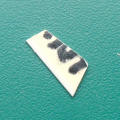 |
Option 2 -
Stage 3
Cut a blade shape from the
plant label.
Polearms come in a vast range
of styles, so you can vary the shape as much as you like.
|
 |
Option 2 -
Stage 4
Add a plastic collar to an
un-trimmed cocktail stick and attach the blade to the shaft with
super-glue.
|
 |
Option 2 -
Stage 5
Trim the point from the other
end of the cocktail stick. |
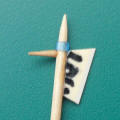 |
Option 2 -
Stage 6
Attach the point to the back
of the shaft as shown.
|
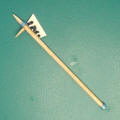 |
Option 2 -
Stage 7
You can add a second plastic
collar at the base of the shaft if you like.
|
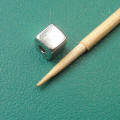 |
Option 3 -
Stage 2
Shave one end of a cocktail
stick to allow one of the beads to be slid onto the wood. |
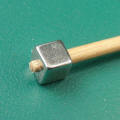 |
Option 3 -
Stage 3
Attach the bead with a drop
of superglue if needed. Trim the point, or leave it if you prefer.
|
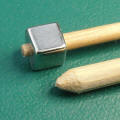 |
Option 3 -
Stage 4
Sharpen the end of a kebab
skewer or plastic rod with the craft knife. Sand the point to smooth it.
|
 |
Option 3 -
Stage 5
Cut the pointed end off the
skewer and attach it to one side of the bead. |
 |
Option 3 -
Stage 6
Add a blade cut from the
plant label as shown above. |
 |
Option 3 -
Stage 7
I added a couple of small
triangles to help strengthen the joint and add extra detail. |
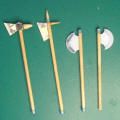 |
Examples 1
The picture shows some of the
completed polearms.
|
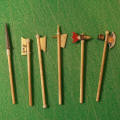 |
Examples 2
Here is another batch of
polearms made using similar methods.
|
 |
Examples 3
Six polearms painted and
arranged on a rack.
Weapon Racks
|
|
Spears
(Click thumbnails for
larger images) |
|
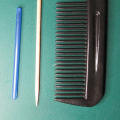 |
Materials & Equipment
Plastic comb
Cocktail
sticks
Plastic tube
(cotton bud shaft)
Superglue
Craft knife
Paint & paintbrush |
 |
Stage 1
Trim both sharp ends from a
cocktail stick. Cut the stick to a shorter length if desired. |
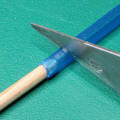 |
Stage 2
Cut a short length of plastic
tube, to fit over one end of the stick and hold the spearhead securely in
place. |
 |
Stage 3
Cut a tooth from the comb. |
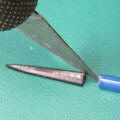 |
Stage 4
Check that the comb-tooth
fits inside the plastic tube - if it is too wide then trim a little from
each side and try again until you get a snug fit. |
 |
Stage 5
Apply a small drop of
superglue into the plastic tube. |
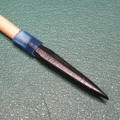 |
Stage 6
Push the spearhead into place
and allow the glue to set. |
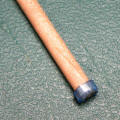 |
Stage 7
(optional)
If you like, you can add a
small piece of plastic tube to the heel of the shaft. |
 |
Stage 8
Spray with black primer and
allow to dry. I used a strip of post-it note to mask the shaft of the
bottom spear. |
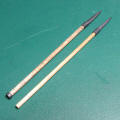 |
Stage 9
Paint in your choice of
colours - I used a gunmetal basecoat with silver highlights for the
metal parts. If you wish, paint the shafts with a shade of brown, or... |
 |
Stage 10
For the spears which had the
shafts primed, I scraped off most of the paint with my craft knife
before applying a brown ink wash to all the shafts. The result looks
like ash wood.
Ash Wood
|
 |
Example
Here is a rack of
spears made using the same techniques.
Weapon Racks
|
|
|
|
 |
Spears Video on YouTube
How to make spears from cocktail sticks and comb
teeth. |
|
|
|
Javelins
(Click thumbnails for
larger images) |
|
 |
Materials & Equipment
Plastic
cocktail forks
Cocktail
sticks
Plastic tube
(cotton bud )
Superglue
Razor saw
Craft knife
Paint & paintbrush |
 |
Stage 1
Trim both sharp ends from a
cocktail stick. Cut the stick to a shorter length if desired. |
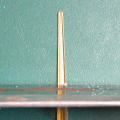 |
Stage 2
Trim the teeth from a
cocktail fork using the razor saw. I found that around 20mm (4/5") to be
a good length which fit snugly inside the plastic tube. |
|
 |
Stage 3
Cut a short length of plastic
tube, to fit over one end of the stick and hold the spearhead securely
in place. |
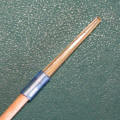 |
Stage 4
Apply a small blob of
superglue into the tube to hold the pieces securely. |
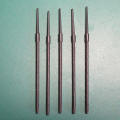 |
Stage 5
Spray with black primer and
allow to dry. Mask the wooden shafts if desired. |
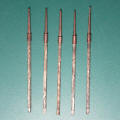 |
Stage 6
Paint in your choice of
colours - I used a bronze basecoat with gold highlights for the metal
parts. If you wish, paint the shafts with a shade of brown, or... |
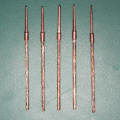 |
Stage 7
Scrape off most of the paint
with a craft knife before applying a brown ink wash to all the shafts.
The result looks like ash wood.
Ash Wood
|
 |
Example
Here is a rack of javelins
made using this technique.
Weapon Racks
|
|
Boar Spears
(Click thumbnails for
larger images) |
|
 |
Materials & Equipment
Plastic
cocktail forks, Cocktail
sticks
Plastic rod or
wire
Plastic tube
(cotton bud )
Superglue, PVA
Pin vice and drill bit
Razor saw, Craft knife
Paint & paintbrush |
 |
Stage 1
Follow Stages 1-4 in the
Javelins tutorial, with one minor tweak - make
the connecting tube in Stage 3 a little longer as shown in the next
image. |
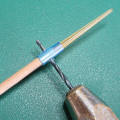 |
Stage 2
Drill a hole through the
centre of the tube and stick as shown in the picture. |
|
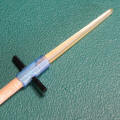 |
Stage 3
Insert a piece of plastic rod
or wire through the hole, leaving 3-4mm protruding at either side. I
used a piece trimmed from a brush tine which was left over from making
Shortswords.
Glue this in place if required. |
 |
Stage 4
Apply a small blob of
PVA to each end of the plastic rod, and allow to dry. Repeat as
necessary to create a small knob at each end of the cross-bar. |
 |
Stage 5
Spray with black primer and
allow to dry. Mask the wooden shafts if desired. |
 |
Stage 6
Paint in your choice of
colours - I used a pewter basecoat with silver highlights for the
metal parts. If you wish, paint the shafts with a shade of brown, or... |
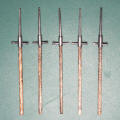 |
Stage 7
Scrape off most of the paint
with a craft knife before applying a brown ink wash to all the shafts.
The result looks like ash wood.
Ash Wood
|
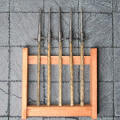 |
Example
Here is a rack of
boar spears made using this technique.
Weapon Racks
|
|
Cloaks
(Click thumbnails for
larger images) |
|
 |
Materials & Equipment
Plastic milk
bottle
Craft knife or scissors
Paint & paintbrush |
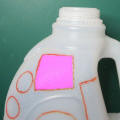 |
Stage 1
Cut out a panel
from the plastic milk bottle as shown. It is easier to cut the panel
larger than required, then trim it if necessary.
|
 |
Stage 2
Draw a template on a piece of
paper using a model figure as a
reference to get the size right. Alternatively, print the PDF below and
use one of those templates. |
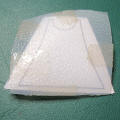 |
Stage 3
Tape the template to the
plastic panel. |
 |
Stage 4
Cut around the shape with a
sharp craft knife. I found it easiest to remove the neck section first. |
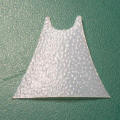 |
Stage 5
Remove any tape which is
still attached to the piece. |
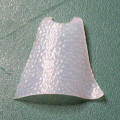 |
Stage 6
Curve the plastic to form a
more natural, rounded shape. |
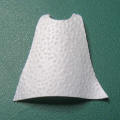 |
Stage 7
Apply a coat of primer and
allow to dry. |
 |
Stage 8
Paint in your choice of
colours - I went for shades of red to match the figure the cloak was made for. |
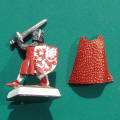 |
Stage 9
I attached the cloak with a
small blob of blu-tack to allow it to be removed. If you prefer you
could glue it in place and add clasps from epoxy putty at the shoulders. |
 |
Example 1
Here is the finished cloak
attached to a knight figure. |
 |
Example 2
The knight figure seen from
the side. |
 |
Templates
Click the image to open a PDF
file with templates for 4 variations on cloaks. The outlines
should be roughly right for 28mm scale, when printed at Actual
Size. |
|
|
|
|
|
Greaves
(Click thumbnails for
larger images) |
|
 |
Materials & Equipment
Plastic milk
bottle
Craft knife or scissors
Hole punch
Paint & paintbrush |
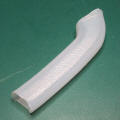 |
Stage 1
Cut the handle from the milk
bottle.
|
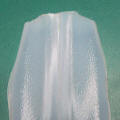 |
Stage 2
Cut along the seam on the
inside face of the handle. This should give you two textured strips and
a smooth strip with a seam. |
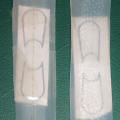 |
Stage 3
Draw a template on a piece of
paper using a model figure as a reference to get the size right.
Alternatively, print the PDF below and use one of those templates. Tape
the template to the plastic panel. |
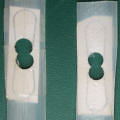 |
Stage 4
Remove the concave piece of
material using a suitable hole punch. This is much easier than using the
craft knife for this step. |
 |
Stage 5
Carefully cut around the rest
of the template with a sharp craft knife. You may need to curve the
plastic again, as the cutting process tends to flatten it out. |
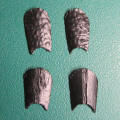 |
Stage 6
Apply a coat of primer and
allow to dry. |
 |
Stage 7
Paint in your choice of
colours - I opted for shades of green on the textured pair, and bronze
with gold highlights on the smooth ones.
|
 |
Templates
Click the image to open a PDF
file with templates for 4 variations on greaves. The outlines should be
roughly right for 28mm scale, when printed at Actual Size. |
|
Breastplates
(Click thumbnails for
larger images) |
|
 |
Materials & Equipment
Plastic milk
bottle
Craft knife or scissors
Paint & paintbrush |
 |
Stage 1
Cut one of the bottom corners
from the plastic milk bottle as shown. |
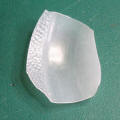 |
Stage 2
This section of the bottle
has a smooth texture, and curves in two directions, so it is perfect for
a breastplate. |
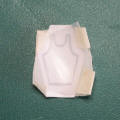 |
Stage 3
Draw a template on a piece of
paper and tape this onto the plastic section. Use a model figure as a
reference to get the size right. Alternatively, print the PDF below and
use one of those templates. |
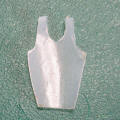 |
Stage 4
Carefully cut out the shape
of the breastplate with a sharp craft knife. |
 |
Stage 5
You may need to bend the
plastic back into shape, since the cutting process tends to flatten out
the curves. |
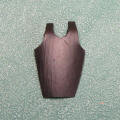 |
Stage 6
Spray with black primer and
allow to dry. |
 |
Stage 7
Paint in your choice of
colours - I used a gunmetal base coat, drybrushed with silver highlights. |
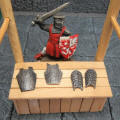 |
Examples
A couple of breastplates on a market stall along with a pair of greaves. |
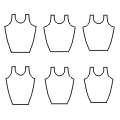 |
Templates
Click the image to open a PDF
file with templates for 8 variations on breastplates. The outlines
should be roughly right for 28mm scale, when printed at Actual
Size. |
|
|
|
|





